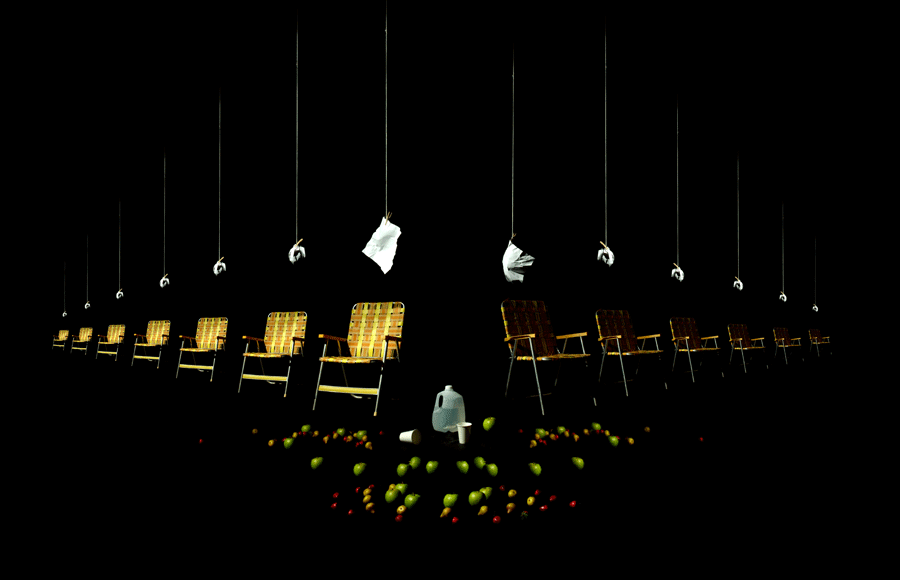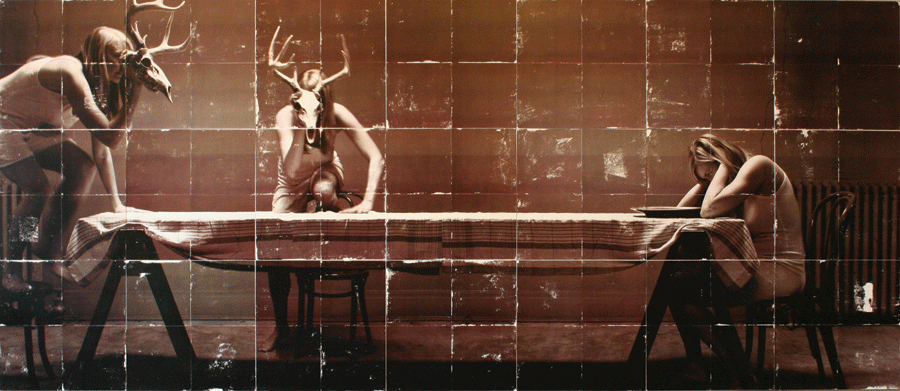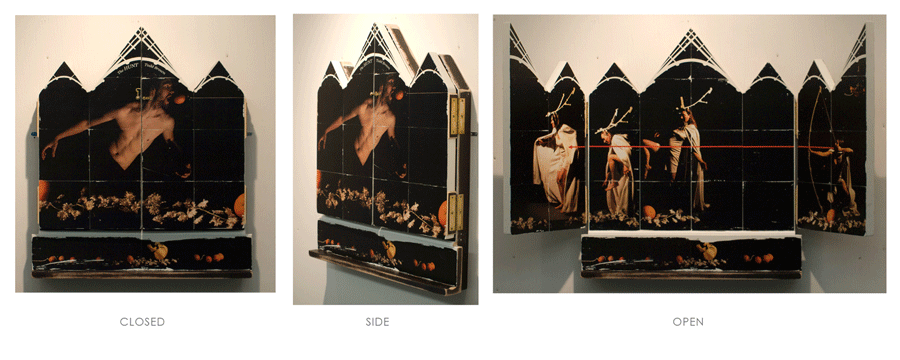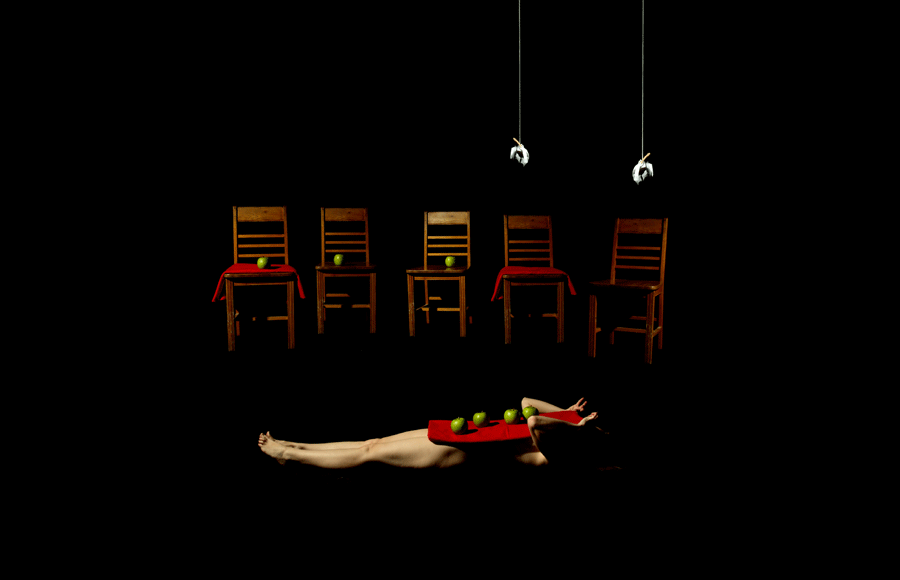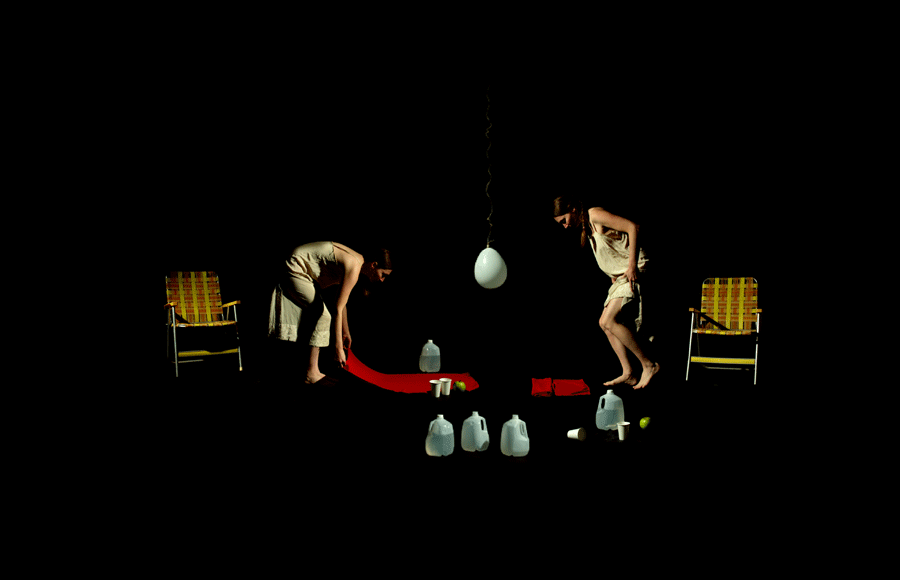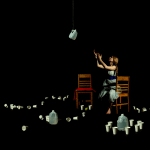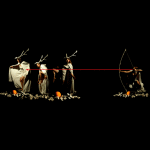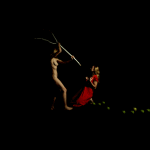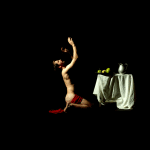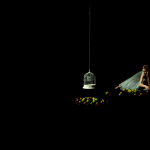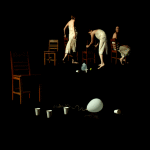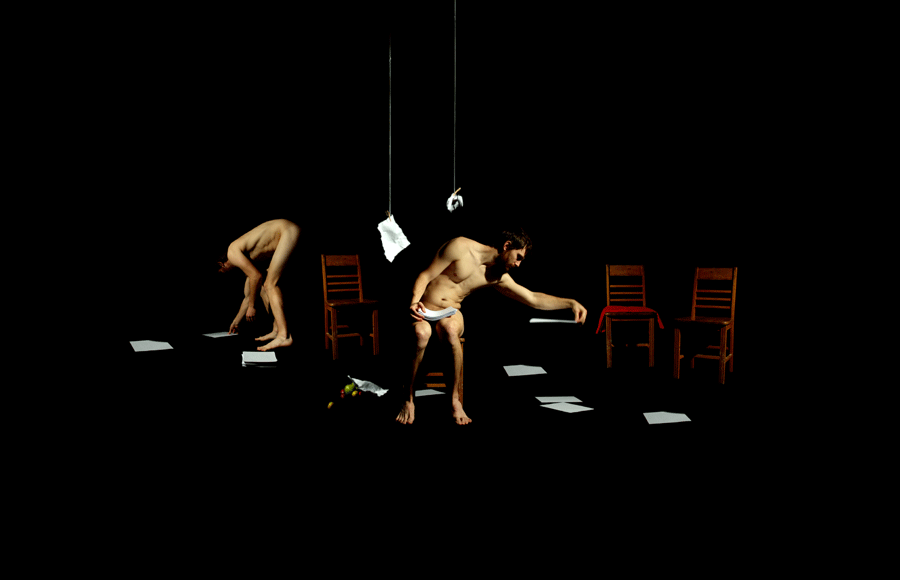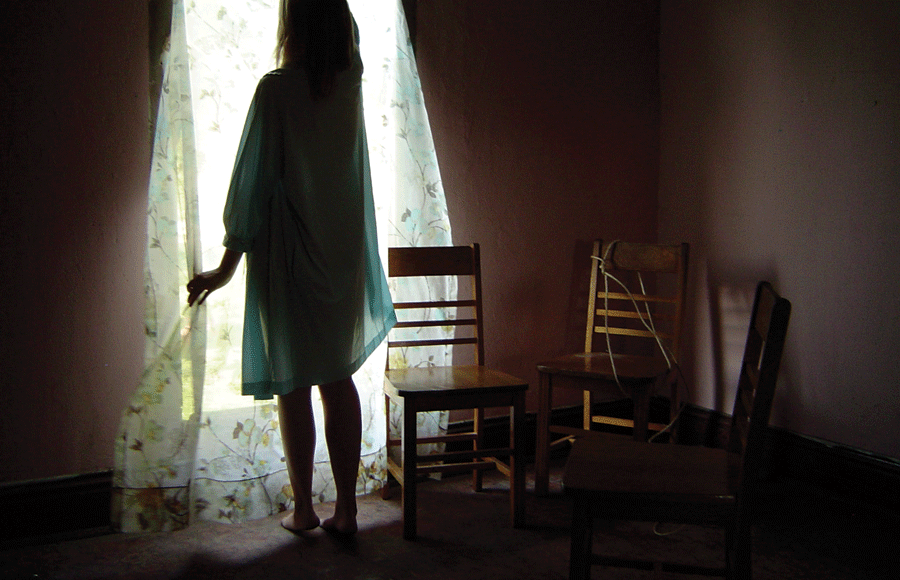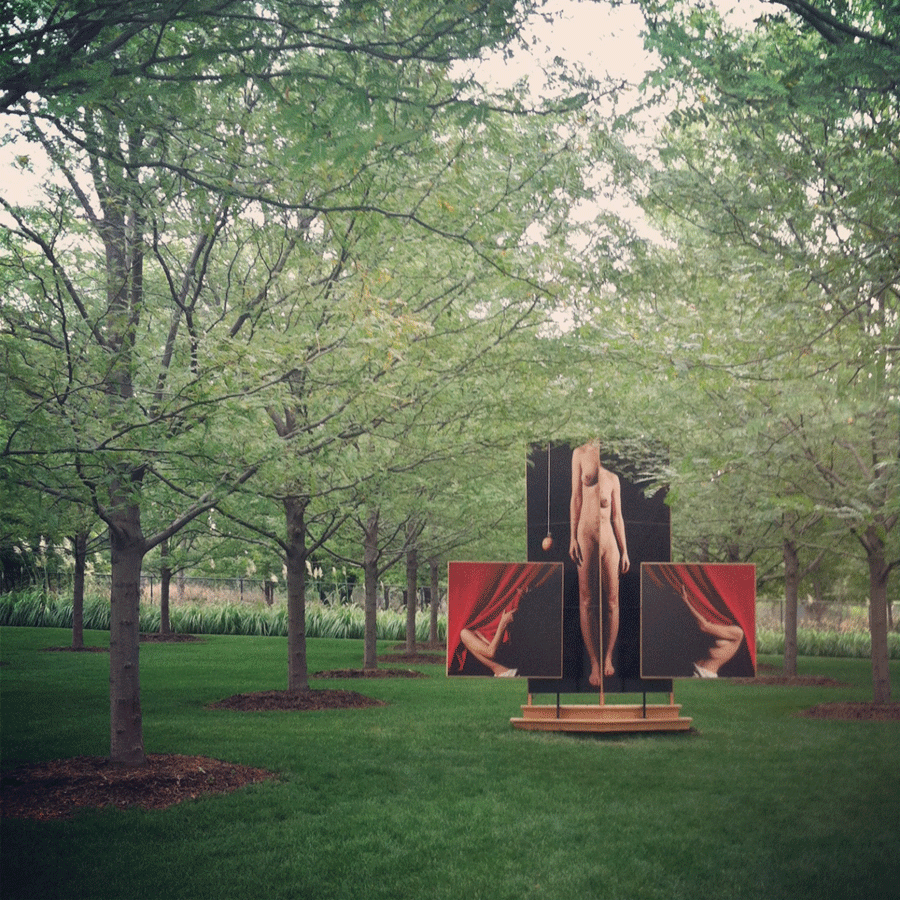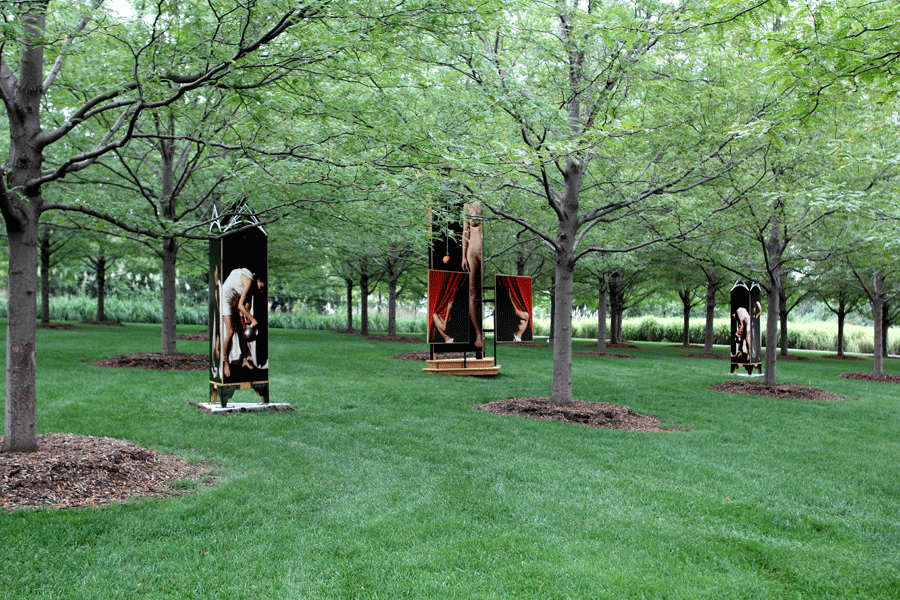The photography of Todd Allan Brown is both striking and consuming. Having graduated from the University of Nebraska-Lincoln with both Bachelor (1993) & Master (1995) degrees in Architecture, Brown is no stranger to aesthetic possibilities and design. With no “formal” training in photography, close study of respected photographers work, and learning by trial and error has bridged that gap. Living in Hastings, NE and working as both architectural designer and carpenter, his work in historic renovation has gained him access to the spaces he uses as settings for his photography. His most recent series, BLACK/CHAIR caught my immediate attention. The stark black backgrounds present crisp figures and saturated objects…the clarity of image reminded me of fine art paintings from long ago. Once captured, these images are given texture and life through hand-rubbed, photo-transfer built from wood blocks on a grid that can be lifelike or even larger, so that a viewer may step into the room and experience the moment captured. Oftentimes, architectural elements such as doorways, windows, and altars are used when bordering the images to both apply meaning and shape.
“The images I construct are flashes of my internal mythology…apprehensive and unscholarly. The characters are always moving, distinctly and honestly, toward a quieter place – staged…but very active. There is consent to being witnessed, and I watch this effort – repetition and emotion – emphatically. I am looking for the most basic reactions – the moments we instinctively know to be important – the rush of seeing bare skin or an approaching storm, pulling a tooth, singing at a funeral. Here longing, loss and sorrow negotiate with joy and relief. In this movement we exercise our desires, or simply show someone else our dearest habits…our interpretation of the myth. Life goes on. We prevail or pass, with grace.” Read on to learn about the past, present, and future of Todd Allan Brown…
Emily Frankoski: Where are you from originally and where do you now reside? How did you get “from here-to-there?”
Todd Allan Brown: I am from central Nebraska. Lived most of my childhood on a farm outside of Harvard, NE. After graduate school, my wife and I bought what had been the town school since 1903 in Glenvil. My grandmother had gone to that school, we had heard that they we considering demolishing, instead…they sold it to us for $1. That was a huge shift in our lives and the beginning of our design build career. We eventually moved from the schoolhouse and continued to work with other historic building projects in the Hastings area.
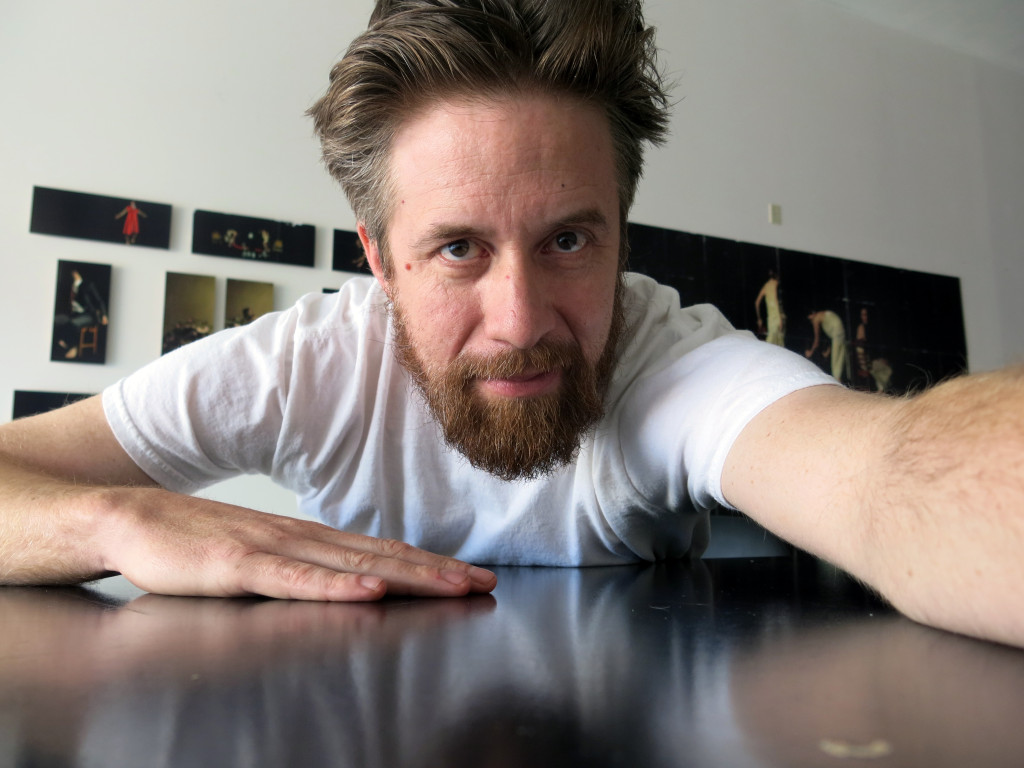
EF: What did you want to be when you grew up? How does that compare to what you are living out in your adult life? Has your journey been linear or non-linear?
TAB: I always had “artist” in the back of my mind. But when I considered college, or a career…Veterinarian was the direction I assumed I would go. At the last minute, because of my parents foresight, I traded it all for Architecture. The way I have used Architecture, or the skills related, has been non-linear, but thats good for me. Thankfully it all can transform and adapt.
EF: If you haven’t done so in the previous answer, explain your general background? What were you like as a kid/what type of student were you/what did you spend your free time doing?
TAB: I was the type of kid that enjoyed studying. I thrived on math and science, but always had something artistic going. I was a bit of a loner. I lived on a farm with trees and a creek…a big old barn. I had a wide territory—everywhere I could walk that was connected by the creek or on the creek itself in a borrowed canoe. So I was out and about but would come home and happily spend the rest of the night with Algebra or sketching…playing guitar. I was scattered, much like I am now. Getting good grades and achieving scholastically was my main tool for confidence building. (Did I mention I was a loner?)
EF: How did your relationship with art begin? What is your background in art?
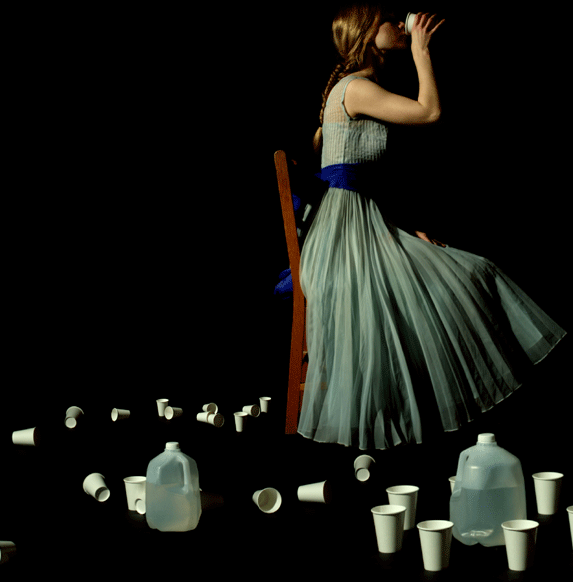
TAB: I have no formal art study to claim. My training has come from closely watching others then stumbling around. In architecture school I was exposed to several aspects of drawing and design, which I rely on heavily. I’ve been influenced by filmmakers like Krzysztof Kieslowski, Mad Magazine, and full-on geeked out bridge engineers.
EF: Is art your full-time career?
TAB: Art is not my full-time career. I work as a self employed designer and carpenter. Although Art it is not a full-time career, I have been able to give it more time lately. I can see myself adapting my other passions to fit the framework of art. Should it one day resemble a career I am sure it will include architecture, construction, design…as well as photography.
EF: Are their struggles to being an artist or has it always paid the bills?
TAB: At times, it can be a struggle to justify the time and expense, but really no different than any other passion I have pursued. I am beginning to see some payback from the upfront work. Not only in terms of “paying the bills” but a feeling of artistic control and satisfaction.
EF: What would you call your prominent medium and how would you explain it to a novice?
TAB: I produce images from studio set performances with live models and still lives. These images are printed onto panels via a photo-transfer method that requires “eroding” away the paper backing of the print with water and your fingers. Its crazy really, it can be painful at times, labor intensive and imperfect, but gives a worn, soft surface to the image. The final piece could be a very large flat print, or sculptural such as cabinet triptychs.
EF: How would you describe your artwork in 4 words or less?
TAB: soft primal dreams
EF: In your opinion, why is what you do important? Why do you create what you do?
TAB: I need a way to express myself and converse with the world. All of this is an outlet and a mode of communication. Also, I think it is important to show a dedication to a passion…whatever it may be.
EF: If you weren’t an artist, what would you be and why?
TAB: I doubt I will every be just one thing…but, I have seen pictures of pig herders in Italy, the guys that feed them under the acorn trees. Just a stick and a satchel that I assume holds bread, wine and some top notch stinky cheese. Walk the pigs out under the trees, have a lunch then walk them back. I think I could give that a try.
CURRENT & FUTURE PROJECTS
EF: Tell us a little about your most recent series BLACK/CHAIR. What was your inspiration for this series?
TAB: The initial inspiration for the compositions was to convince the viewer that they were standing at the edge of the entrance to a room…so I knew that the final image prints were going to be large, with a nearly full scale human perspective. The largest finished piece so far is nearly 7’x10′. As for theme, its a private space, a quiet moment. I like the direction a chair can lead you when entering a space. The other elements are important as well and they have all been chosen to be immediately recognizable with an inherent physical element such as sitting in a chair or drinking from a cup.
EF: To gain perspective, what are the dimensions of these images?
TAB: I am printing small versions (7″ x 16″) but they are truly intended to be large, to gain proper human scale, say 7′ x 16’.
EF: What camera do you use?
TAB: Canon 60D
EF: What is the main message you are trying to get across through this series? What do you want the viewer to “take away”?
TAB: I would prefer that the viewer would have an experience more than something to take away. Maybe the characters in the images are unashamed in their openness or sorrow or confusion/searching…allowing a chance for us to relate and have an experience or connection.
TAB: Lately, I have been experimenting with ways to make the images I produce more dynamic, beyond 2-D somehow. Change the frame, make it sculptural drawing inspiration from alter triptychs and cabinets, even the architectural spaces (rooms) they were conceived in. I am also developing a standard print strategy (on aluminum or large format photo transfers on masonite), even though I feel that framed photographs are the earned territory of studied photographers (which I do not consider myself yet one).
EF: You mentioned you were preparing for a solo show at the Museum of Nebraska Art. Will BLACK/CHAIR be exhibited…or?
TAB: Yes, images from this series will be there in various forms. The Nebraska Now Gallery series is meant to highlight current work. I am sure I will continue to have photoshoots right up to the deadline and pushing to get new pieces into the show.
INSPIRATION, CREATIVE PROCESS, AND GENERAL Q’S
EF: What are the stories you like to tell in your artwork? What are you inspirations and common themes that can be found?
TAB: We are getting a view into a room, a sanctuary of sorts, with the opportunity to interact or be a part of a small personal ritual. I spend a lot of time in thrift stores gathering props and costumes, but also, I experience them as a museum of sorts, a display of the things we keep around us. I enjoy finding something well crafted, or an item that is seemingly so personal and odd that you can’t imagine it was given away. I like to pretend these items are abandoned shrines or tools. Cups become alters, that kind of thing. This informs or prepares me somehow. I know that sounds vague, but thats the start. From that point everything comes in, I want the potential for everything to be present. I am finding that a simple image does not necessarily portray a simple concept, especially when dealing with the human figure. If you offer a few clues, it narrows the possibilities. My very first organized studio/set site was a house that was being slowly torn down by the man next door to it who had purchased it. It had been owned for decades by a widow and was in terrible shape. It was pink. I noticed it one day when I drove by and a wall in the kitchen had been torn away. I asked permission to use the space. Gratefully I was allowed, and thankfully he was slow to tear it down. I was able to use it for about a year. It was an amazing opportunity because I could do anything to the floor the walls, it didn’t matter. It was all to be torn down anyway. I would show up to prepare for a photoshoot and another wall might be open. It kept me on my toes. The first real concept for my work came when I pulled up the carpet from the large bedroom. I could see the wear patterns in the floor, could see were the furniture sat, the paths from the door to the bed. It was all so fascinating. I began to think a lot about this woman’s daily routines and those thoughts found their way into the photoshoots. The concept of personal daily rituals has stuck with me since.
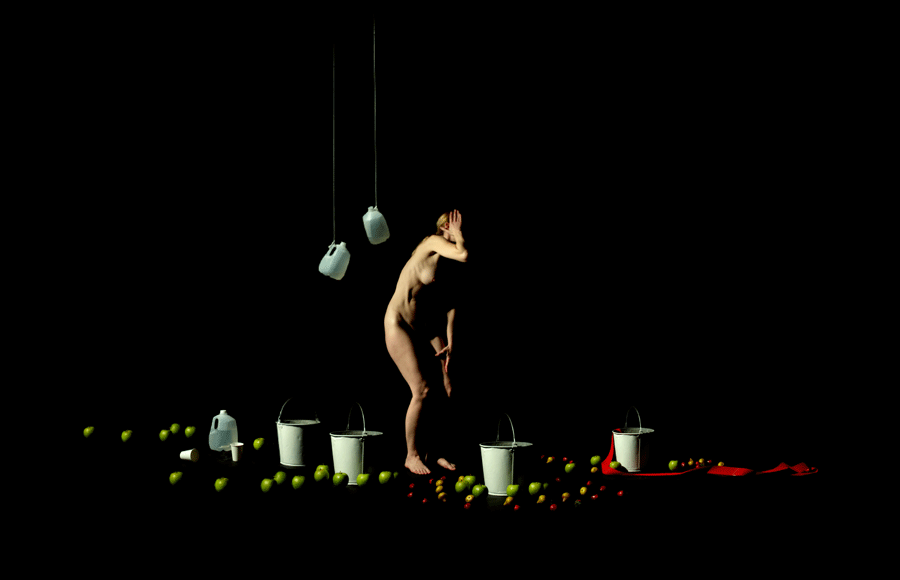
EF: Walk us through your creative process. How do you get from point A to finished product? How long does one piece of artwork usually take you?
TAB: When I am not shooting, building, or printing, I am sketching. I am almost always building ideas in a sketchbook. This gives me direction for coming photoshoots or the composition of the print or the shape of the new construction. Photoshoots are pretty unstructured. Rarely do I enter a photoshoot with a specific piece in mind. I usually have a starting point, maybe even a page of sketches and notes to give direction, but that typically is out of reach quickly and the shoot/performance takes its own direction. These images become raw material for the next image, or to inspire the next set of sketches that will inform the next photoshoot. It’s much like a cycle which eventually produces a final product. Then its a process of sorting through images, deciding which format to pursue, sketching, paper mock-ups of sculptural pieces and test prints. Amongst all this are conversations with friends, critiques if I can get them, more photoshoots, edits, adjustments. If this leads towards a sculpture, then I move to the shop. All the while, more shoots, sketches and new ideas that will completely change my original idea. Eventually the final print/transfer process. I enjoy every bit of it…and I enjoy that it is an integral part of my overall daily routine.
EF: What have you learned about yourself through your artwork/projects?
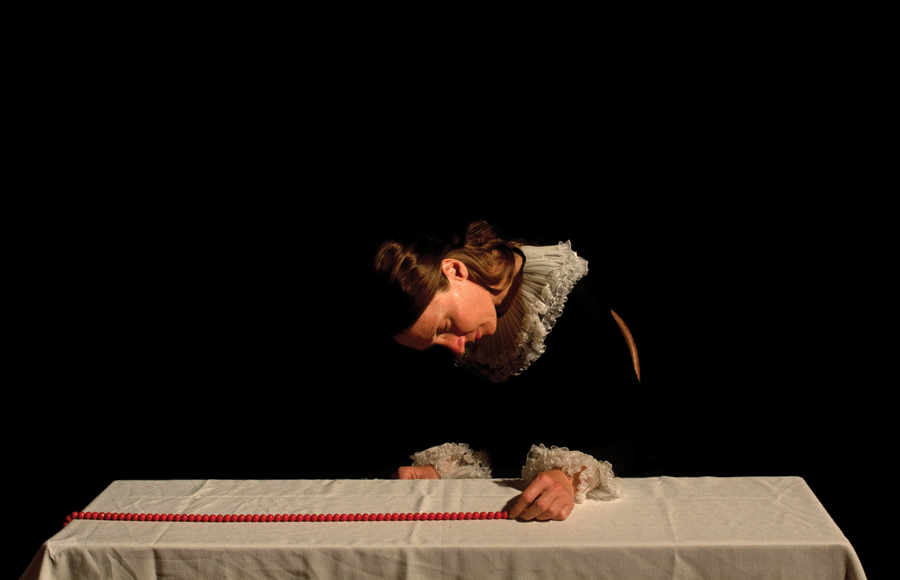 TAB: What ever I have or haven’t figured out will hopefully show up in the next piece.
TAB: What ever I have or haven’t figured out will hopefully show up in the next piece.
EF: Do you work on one project at a time until finished – OR – do you work on multiple projects simultaneously?
TAB: I usually have several projects going, but once it’s started I try to keep it moving at a steady pace.
EF: Do you ever have the artist equivalent of “writers block?” How do you get past this so you can keep/finish creating?
TAB: An advantage of having so many directions moving at once is that I have the ability to change my focus and give a little space to an issue that is blocked. Also, coffee.
EF: When you are not creating, what might one find you doing?
TAB: Cleaning up the mess I just made, a trip to the thrift store, then a drink on the porch, lumberjackie kinda stuff, catching up my other obsessions.
EF: If you had to pick one piece of your work to represent yourself as an artist, which would it be and why?
TAB: It would be something from the Pink House series (see below). I had so much freedom there. In a way, what I do now is an attempt to recreate that space and time.
EF: For whom do you create? Who is your audience?
TAB: I suspect like most artists I strive to appeal to the broadest audience possible, communicate some universal human experience that, if presented sincerely, it’s ok if it is incomplete or mysterious. There will still be something recognizable there.
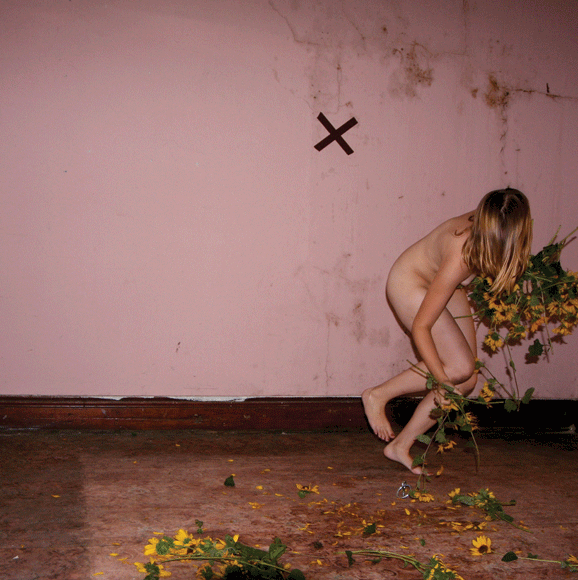
EF: Currently, you mainly exhibit your work within Nebraska. Are you looking into exhibiting elsewhere in the future?
TAB: Yes. I am currently reaching out to select galleries in other states.
EF: How do you promote your work? Do you seek out opportunities or do they come to you?
TAB: My website is the core of my promotion, from that I produce printed portfolios for mail.
EF: How do you continue to challenge yourself and grow as an artist?
TAB: I hold pretty high standards for my future. When I visit MOMA I am imagining where my piece would hang and challenge myself to live up to the quality in the room. It’s arrogant and humbling at the same time.
EF: Do you sell your artwork? If-so, where can we buy it?
TAB: I am currently represented by Modern Arts Midwest in Omaha. I can also be contacted through my website.
EF: To date, what project has given you most satisfaction?
TAB: I installed a large scale photo/sculpture in the Duncan Sculpture Garden in Lincoln, NE (see below). I was given a dream site, a grid of 70 Honey Locust trees in a spectacular garden with the challenge of creating an outdoor photographic display. The Duncans are so supportive and welcoming. I got to involve other artists and several friends. The project was very enjoyable and well received.
EF: What artists do you admire and why?
TAB: William Kentridge is so precise with his story telling and is always sincere. David Lynch has no fear of the unknown and isn’t ashamed to share it. Kara Walker is as bold as I hope to be.
EF: Do you have a favorite piece of art (other than your own)?
TAB: I recently travelled to Rome to see all of the Carrivagios in their original chapels. Along the way I taken by several Bernini sculptures and found my current favorite Ecstasy of Saint Teresa.
EF: What are you currently reading?
TAB: “Dracula” Bram Stoker, “”An Anthropologist On Mars” Oliver Sacks, and I always have the “Building Stories” box from Chris Ware nearby.
To see more from Todd Allan Brown visit:
